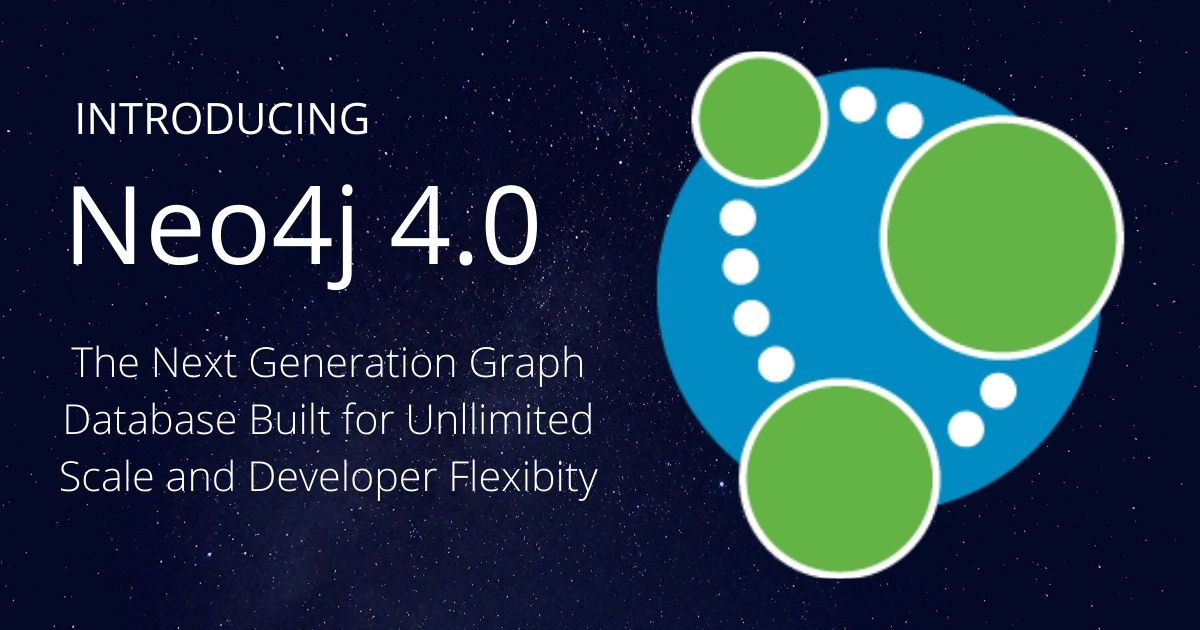Neo4j 4.0: Aims better scalability, security, and performance

Data Analyst
Experienced data analyst working with data visualization, cloud computing and ETL solutions.
February 27, 2020
The databases that use graph structures for queries and analytics that are contextual. Semantic queries help in retrieving information based on syntax. These queries deliver precise and clear results that answer fuzzier and open matched questions via pattern-matching as well as digital reasoning. The graph, involved, relates the various data collection of nodes and edges; with the edges representing the relation between the nodes. For graphical databases, the aforementioned relationship (edges) holds the key to unlock the desired data. This relationship is visualized by using graphical databases and is hence useful when it comes to inter-connected data.
NoSQL databases, which were created to address the limitations of existing relational databases, form the crux and foundation of graphical databases. The underlying storage mechanisms of various graphical databases vary with some depending on a relational engine to store the graphical data in a table. Some other graphical databases use a document-oriented approach along with a key-value store for information storage purposes: makes them NoSQL structures.
Data retrieving from a graphical database require a query language other than SQL and the languages used include SPARQL, Cypher, and Gremlin. Some graphical databases can be accessed via Application Programming Interfaces (APIs).
Neo4j
Graphical database management system developed by Neo4j.inc: developers describing it as an ACID (atomicity, consistency, isolation, durability) compliant transactional database. It comes with native graph storage and subsequent processing. Neo4j is regarded as the most popular graphical database (ranking given by DB-engines: an authority that ranks database management systems).
This graphical database is available in GPL-3 licensed open-source platform (community edition) with online backup and high availability extensions: licensed under a closed-source commercial license, with Neo also licensing Neo4j under appropriate terms.
Neo4j, the graphical database, is implemented in Java. This is accessible through Cypher Query Language as well, via transactional HTTP endpoint or binary bolt protocol.
Four versions of Neo4j have been released by Neo4j.inc: the first version got released in February 2010 and the last version (Neo4j 4.0) released in February 2020. This graphical database comes in two editions that include Community and Enterprise, with a dual license (GPL v3 and commercial). The community edition is free and the enterprise edition, available under a closed-source commercial license, allows clustering of data, hot backups, and effective monitoring.
In Neo4j, everything is stored in the form of edge, node, or attribute. As both nodes and edges can be labeled, this will be useful in narrowing searches regards to any relevant data. From version 2.0, indexing of data was added to Cypher with the help of schemas.
Neo4j 4.0
Neo4j is one of the leading graphical databases in the competitive market and they have rolled out a new version recently, which is named Ne04j 4.0. This new version that is the leading native graph database adds on a list of long-awaited horizontal sharding, granular security as well as reactive processing. Neo4j 4.0 brings in new scalability and security features, which is aimed at enterprise deployments.
The security of multi-cloud: It is essential to bring clarity into defining and distributing security responsibilities among third-party partners who deal with various aspects of security. This clarity fulfills the challenge of consistent data-protection across a variety of cloud providers.
Graph databases are essentially optimized to deal with the relationship between various elements, not necessarily through conventional tables. These relationships are effectively expressed via tubular databases. However, this becomes difficult to deal with when considering millions of connections involved.
Internet-Scale Graph Platform
Connections-first approach to applications and analytics across the enterprise forms the crux or basis of Neo4j's graph platforms. This helps an organization to broaden its ability for recognizing the significance of persisting relationships and connections via every transition point of existence. For instance, from idea, design of a logical model, implementation of physical model and operation using query languages, Neo4j is persistent with a scalable as well as a reliable database system.
Neo4j Graph Platform: Built around, Neo4j Native Graph Database
✔ The graph database supports transactional applications as well as graph analytics.
✔ Graph analytics aids data scientists to gain new perspectives on relevant information.
✔ Data integration helps in distilling tubular and big data into graphs.
✔ Cypher Graph Query language acts as a bridge to big data analytics tooling.
✔ Graph technology benefits I communicated throughout the organization via graph visualization and discovery.
✔ Massive graph data is supported by the enterprise architecture of the graphical database.
A Quick glance at the major changes made in Neo4j
Neo4j is undoubtedly the most popular Graph Databases and Cypher Query Language developed by Neo4j, Inc. Neo4j is a scalable, schema free (NoSQL), and ACID-compliant transactional database ranked as the most popular graph database based on the survey conducted by DB-Engines ranking.
The introduction of Reactive Sessions or Reactive Query Processing to Neo4j 4.0 is regarded as one of the main changes made in Neo4j 4.0. Also, the concept of reactive sessions is made available for the community as well as enterprise editions. The idea behind Reactive sessions is that it permits applications to efficiently manage the data coming from Neo4j. The one benefit of using Reactive sessions is that clients can seamlessly handle this streamed data.
The second major change in Neo4j is the introduction of horizontal scaling called Neo4j Fabric. The main advantage of using horizontal scaling or Neo4j Fabric is that it permits the data (graph data) to be shared across different instances. Before the use of Neo4j Fabric, data replication is designed to offer read scaling and high availability.
Other changes made in Neo4j that are new to Neo4j 4.0, but limited to enterprise users are:
✔ Neo4j 4.0 is a flexible data model that has the capability to deploy different databases into a single Neo4j server cluster.
✔ Stringent security and access controls
✔ The use of Memory constraints to restrict queries from overloaded nodes
Why Choose Neo4j? - The notable features of Neo4j
In today's highly connected digital world, there is increasing dependence on the relationship between different data. In this scenario, SQL and NoSQL fail to meet graph-based storage expectations. A graph database is a database model where data is represented in the form of a graph. The nodes of the graph represent entities and the relationships show the association of data (nodes/ entities). More than just a representation of data, Neo4j offers easy retrieval, in other words, traversal of data.
Unlike other databases, Neo4j is a graph database management system that offers operational availability. As a flexible and scalable database, Neo4j works on real-time data and provide transactional integrity without any fail.
For enterprises using legacy systems, it is easy to migrate to Neo4j without affecting their day-to-day operations. There is a stunning list of enterprises that have deployed Neo4 to enhance the functioning of the existing IT infrastructure!
Experimentation with Neo4j - The Future Enterprise level Graph Platform
As an enterprise-quality graph database, Neo4j is a great platform to traverse, and store interconnected data, unlock the hidden patterns or relationship between these data, etc., without using complex structures. Highly used for real-time applications, Neo4j finds various applications in the below-listed domains like:
1. Fraud detection
2. Artificial Intelligence
3. Machine Learning
4. Master Data Management
5. Network and IT operations
6. The Internet of Things
Neo4j vs. RDBMS and other NoSQL

No denying: Usually data stores have their own suitable use cases. If there is a requirement for your project or venture to make maximum advantage of the connections between data points, then its recommended to rely on Neo4j.
Neo4j being the best and leading graph database in the world have many merits as listed below when compared other conventional relational databases of RDBMS and other NoSQL data stores.
Data Storage
Relational Database
This database has a fixed storage. It has tables which are predefined. The tables have rows and columns with connected data and the data is disconnected between tables. The relational database also have a crippling query efficiency.
Neo4j
Neo4j has an index-free adjacency in its graph storage structure. As a result the processing and transactions for data relationships has become more rapid or faster.
Data Modeling
Relational Database
Modelers are used in developing the relational database. After development the database model is translated to a physical model from a logical one. Since the sources and data types must be known beforehand, weeks of downtime is required for the implementation of any changes or alterations.
Neo4j
The graph database Neo4j is a flexible data model with no discrepancy between the physical and logical model. Neo4j is a "whiteboard-friendly" data model where data sources and data types can be included or altered at any time according to your convenience. This results in a great reduction in the development time required as well as true agile iteration.
Query Performance
Relational Database
The number and depth of the relationships queried acts as a hindrance to the data processing performance relational database.
Neo4j
There is an ensured zero latency and an efficient real-time performance seen in graph processing of Neo4j. The depth and number of JOINs or relationships queried does not affect the performance or cause any delay.
Query Language
Relational Database
In case of the query language of SQL, there is a visible increase in complexity depending on the number of JOINs required for the connected data queries.
Neo4j
Neo4j uses Cypher which is an efficient native query language that allows the description of the relationship queries in an expressive way.
Transaction Support
Relational Database
Enterprise applications and projects require ACID transaction support for a more reliable and consistent data.
Neo4j
For reliable and consistent data round the clock, Neo4j holds on to ACID transactions. It is an apt choice for carrying out always-on and complicated global enterprise applications.
Processing at Scale
Relational Database
The scale up architecture is possible but it will be a costly process. The relational database scales out through replication. The complex data relationships in this database cannot be harvested at scale.
Neo4j
Graph database management system scales for pattern-based queries. The data integrity is maintained via replication by the scale out architecture. There is a possibility of massive scale up by incorporating IBM POWER8 and CAPI Flash systems.
Data Center Efficiency
Relational Database
Server consolidation is a more affordable option when compared to scale up architecture. Considering the energy invested, management time and costs, scale out architecture is expensive.
Neo4j
In the graph database platform of Neo4j, data and relationships are stored natively. There is a visible improvement in performance with the growth of scale and complexity.













